Late-Summer Fluke Fishing in New Jersey
Two Jersey-based captains share tips for catching fluke in the final weeks of the season.
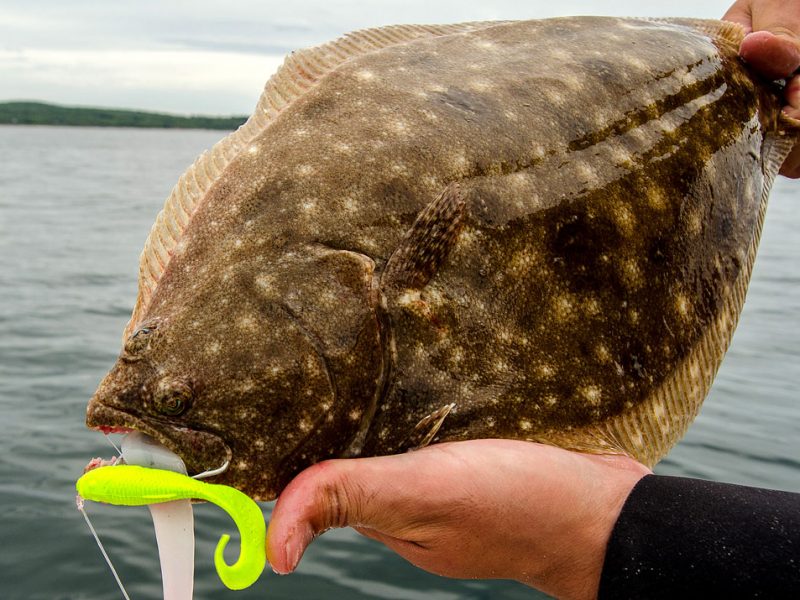
In New Jersey, the end of the summer is bittersweet. Kids head back to school in early September, and the beautiful, but sometimes unbearably humid summer weather makes fishing difficult, as the temptation to stop fishing and take a swim increases with the air temperature. But, for dedicated summer flounder fishermen, late August in New Jersey means that the fluke fishing is as hot as the weather outside. By targeting deep water and plentiful structure with big baits, fishermen catch quality fluke, 8 pounds and over, from Ambrose Channel to the Old Grounds.
Even though depths and conditions vary across the state, there are plenty of similarities in this style of fluke fishing. I spoke to a couple of New Jersey’s finest fluke captains who provided insight into how they help their customers fill the cooler before the final leg of the season in September.
(Note: On The Water is reader-supported. When you buy through links on our site, we may earn an affiliate commission.)
Fluke Fishing with Captain Bob Cope, Full Ahead Sportfishing– Cape May, NJ
Bob Cope of has been fishing the waters of Cape May for over thirty years, which makes him a prime source for inside information on fluke fishing during August. Eager anglers hop aboard his 34-foot 2007 Calvin Beal with ample space to fish, but many of them are unaware of the lengths the captain goes to put his clients on fish.
In August, Cope said that he fishes entirely around hard structure. Fluke, although flat and easily camouflaged in muddy or sandy bottoms, thrive around wrecks, reefs, and rock piles. Full Ahead will go the extra mile (or ten) to put customers on the bigger fish, which are typically found in 90 to 125 feet of water around offshore wrecks at the end of summer. The run is 20 to 25 miles from Cape May, but Cope insists on better fishing conditions due to fewer crowds and less pressure on the fish. At this time of year, keeper fluke are few and far between inside 16 miles.

While the “giant” doormat fluke is occasionally caught on Full Ahead, the quality and consistency is what the anglers enjoy most. The fluke off Cape May are eating well in late summer and tend to be in the 21- to 23-inch range, but the bigger fluke to come over the rail aboard Full Ahead are usually in the 7- to 8-pound range.
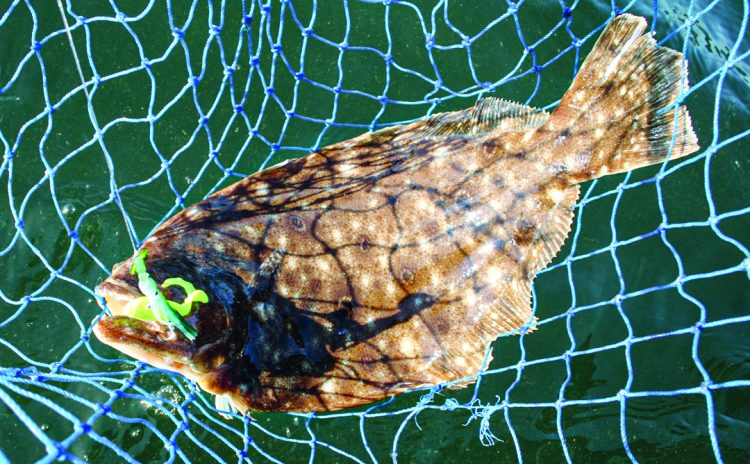
To reach bottom in 125-feet requires a balance in weight; the angler will need enough weight to reach the seafloor without dragging bottom, otherwise they risk hitting a snag. According to Cope, most of the fishing done on Full Ahead Charters is with bucktail jigs and teasers tipped with Berkley Gulp. The captain estimates that 90 percent of his fluke fishing is with artificial baits like Gulp because they outfish bait much of the time. On days when the fluke are especially picky, he’ll rig up a strip of mackerel and some spearing.
There are other disadvantages to bait in the heavy structure where Cope fishes. Dragging a baited rig with a sinker is far more likely to snag hard structure like rocks or coral than a dressed bucktail jig. Bait is also fished entirely different from a bucktail; Cope emphasizes the importance of jigging the bucktail off the bottom to both avoid snags and trigger a bite. The rise and fall of the jig through the water column gives life to the deer hair and the Gulp trailer.
The bucktail rig used on Full Ahead Sportfishing Charters is simple. It consists of a 4- to 6-ounce bucktail jig, like a SPRO Prime Bucktail or Jigging World Premium Bucktail, with a teaser hook tied 18- to 24-inches above the jig. The weight allows the jig to reach bottom quickly, and adjustments can easily be made based on depth change and current. An array of bright-colored jigs and trailers cover the deck so anglers can get experimental with their color combinations. It gets dark towards the bottom in 100-feet of water, and the bright colors are more likely to trigger a strike the more visible they are. Captain Cope strategically chooses his Gulp colors to best mimic the colors of the forage around these reefs and wrecks.
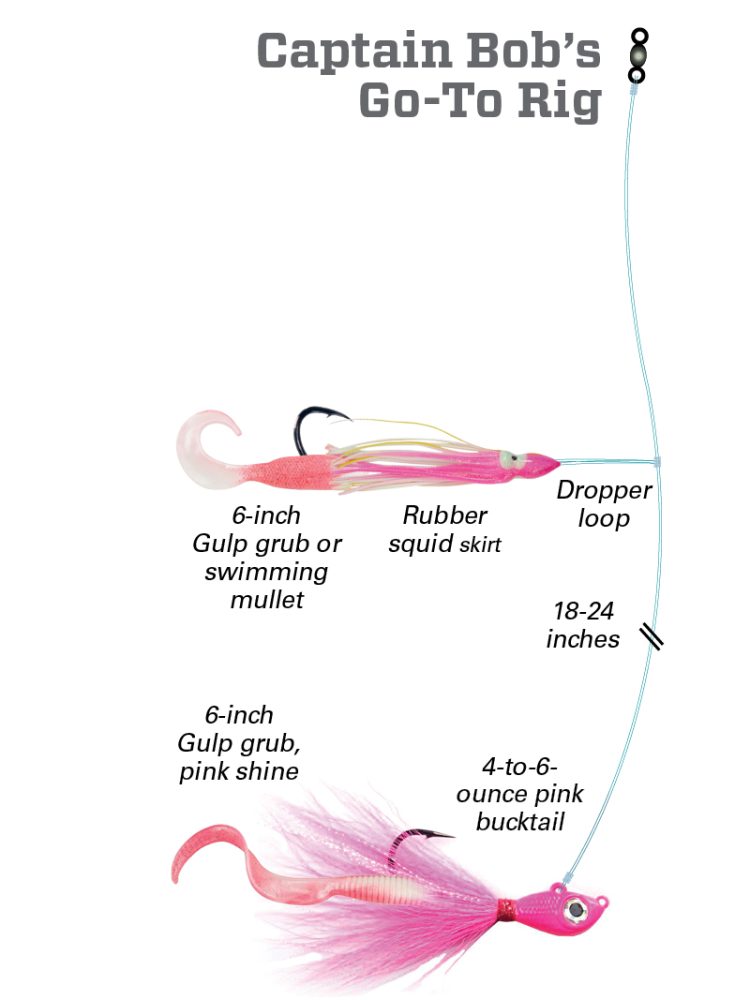
White, pink, green, chartreuse, and orange/red are all fantastic bucktail colors for fluke, and there are Gulp colors that pair nicely with each. Captain Cope’s go-to setup is a pink bucktail with a 6-inch pink shine Berkley Gulp grub. The pink shine color is accented with white, and as Cope described it, the combination perfectly imitates the color and action of a live squid.
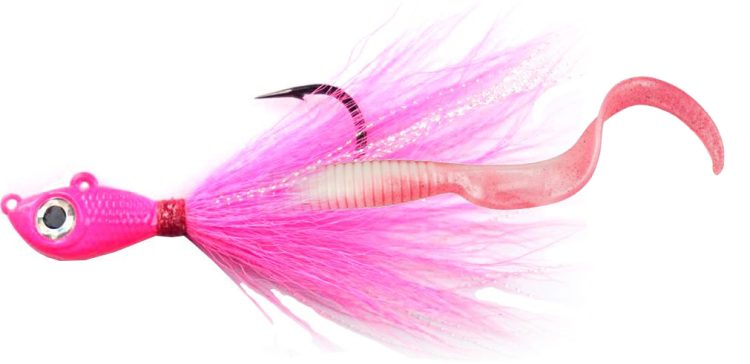
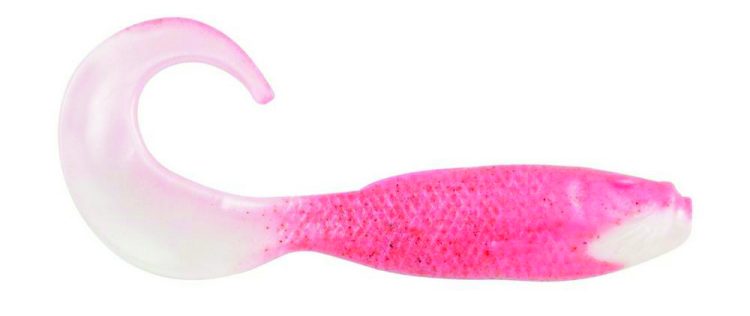
Part of his success is due to theorizing what the fish are feeding on based on depth and type of structure. In rocky areas around 100-feet down, Captain Cope will tie on a bucktail tipped with a 6-inch salmon red Gulp grub to imitate a lobster or crab. There’s never a shortage of Gulp; the captain keeps several packs of every color, size, and style—like grub or swimming mullet—because the fluke’s preferences change daily with water temperature, movement and presence of bait. Some of his customers will even bring a 2-gallon bucket filled with Gulp Alive Recharge Liquid to keep their artificial baits soaking in the powerful scent.
Fluke Fishing with Captain Pete Sykes, Parker Pete Fishing Charters– Belmar, NJ
Just up the coast in central-northern New Jersey, Captain Pete Sykes of Parker Pete Fishing Charters is running fluke trips on the larger of two boats in his fleet, the Parker Pete Express. He spent his childhood fishing in northern New Jersey before working for charter boats around Shark River, a popular location for shallow-water fluke anglers. Today, the Parker Pete Express takes anglers out deep in search of fluke. Here, the quality keeper flatties can be found in shallower water than southern New Jersey.
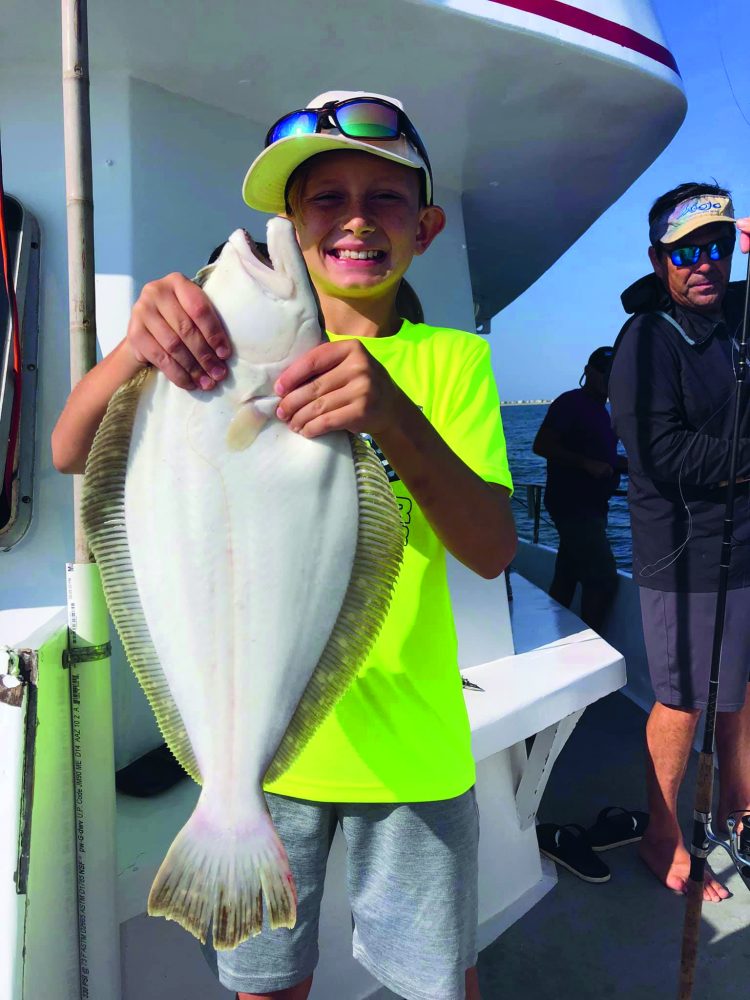
Sykes explained that his charters are typically fishing between 60 and 90 feet of water. In July, the fish can be found shallower than 60 feet, but by August the water is too warm, and the keeper-sized fluke have moved deeper. They’ll find plenty of short fish on hills and lumps for some fun catch and release, but it’s within the deep pockets and valleys where the doormats linger. Along with increased water temperatures, the typical late-summer storms that blow through in mid- to late-July create heave, which stirs up the bottom and forces the fish to relocate to find food. Once the fish move off the structure, following a storm, they may not return, and will continue moving offshore toward deeper structure.
When it comes time to drop a line, Captain Sykes and crew are equipped with an array of baits and pre-tied rigs. On open boat trips, he teaches new anglers how to fish with a bucktail because movement is essential when enticing a fluke to bite. There are times when bait dragging is the appropriate method, though. Even then, the mates will teach anglers to feel for bottom and bounce their sinkers to avoid snags.

The rigs are complete with 5/0 or 7/0 Gamakatsu baitholder hooks that are dressed with squid strips and spearing; these hooks require extra swing behind the hookset to drive that point through the solid jaw. A wide gap hook is more likely to catch a fluke in the lip or the throat, which increases the likelihood of the fish throwing the hook and the angler losing a potential keeper. This is one of the many reasons that Captain Sykes and his customers enjoy fluke fishing with bucktail jigs.
Not every customer comes aboard Parker Pete Express with bucktail jigs and Gulp in hand, so Sykes has made Gulp available to purchase once on board. He keeps an inventory of just about every color, but in the most productive styles—grubs and swimming mullets—there are specific color combinations he finds to be most successful.
When choosing a bucktail, selecting the proper weight is the first decision. The captain favors using the lightest-weighted bucktail that will still get to the bottom and stay in the strike zone. Depending on the current, in 60- to 90-feet of water, Sykes finds a 3- to 4-ounce bucktail will usually do the job. The goal is to keep the bucktail low enough that it bounces off the bottom structure or flutters just above bottom to give movement to the deer hair and the Gulp tail to make an artificial bait appear alive. Additionally, bouncing the bucktail off bottom or jigging it will give motion to the trailer and drive fluke to strike. The idea is to never have the jig at rest, and to avoid snagging bottom; the jigging action helps with that, as well as pitching the jig up-current to use the moving water to the angler’s advantage.
Much like Captain Bob Cope, Captain Sykes does his best to select colors of Gulp that complement the bucktails he carries and closely mimic the forage of fluke in the area. They use bright colors that imitate squid to grab the attention of flatties. Whether fishing in clear or stained water, Captain Sykes finds that white glow, pink shine, and nuclear chicken Gulp grubs and swimming mullets all work well with imitating the shades and movements of squid. They keep chartreuse on hand if the water is particularly cloudy, and in water 90-feet and deeper, new penny Gulp tends to be a top producer because it closely mimics small ling cod. Sometimes when the bucktails aren’t working, they play around with different rigs and presentations on the Parker Pete Express.

Captain Sykes and his crew emphasize the importance of getting experimental with their rigs; they mix and match two types of Gulp on a high-low rig, like salmon red grub and nuclear chicken swimming mullet, unofficially deemed the “Salmonella Chicken” rig. They have even trimmed the tails from grubs for a smaller, scented presentation with minimal action.
No Right or Wrong Rig
When it comes to New Jersey fluke fishing practices in the late summer, it’s clear that deep water is the key to success. But when deciding what to fish with and how to rig it, take it from two of New Jersey’s best fluke captains and break away from traditional expectations. Fluke can be finicky at times, but they can be just as equally aggressive after a minor color change or weight adjustment. There is no right or wrong when it comes to finding the “right” rig or artificial bait, there is only what works.
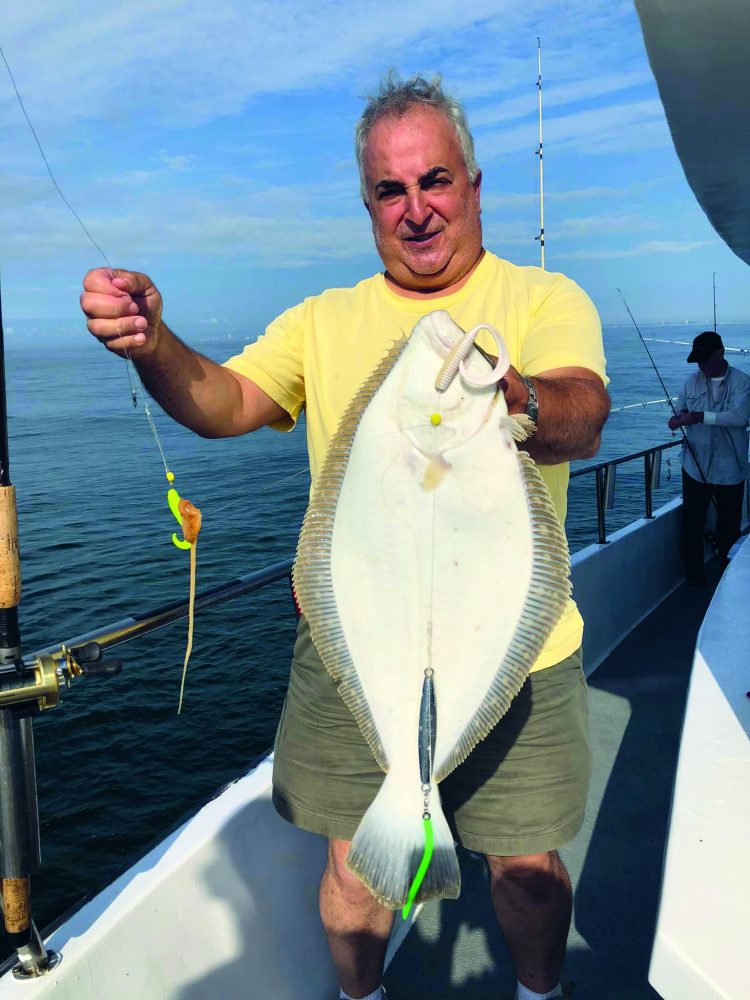
Both captains encourage their customers to change things up and experiment with different bait options. Captain Bob Cope told me, “When nothing works, try something stupid,” and Captain Sykes has even rigged Gulp and bait on the same baitholder hook to produce a bite. Part of what makes fluke fishing so enjoyable in the late summer is the opportunity for a doormat to end the season, whether you’re fishing North Jersey, South Jersey, or anywhere in-between.
Related Content
Fishing Bucktails for Trophy Fluke
Leave a Reply